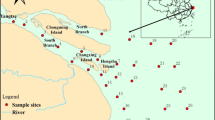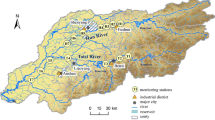Abstract
In this study, a method of positive matrix factorization (PMF) combined support vector machines (SVMs) was adopted to identify possible sources and apportion contributions for trace element pollution in surface sediments from the Jinjiang River, Southeastern China. Utilizing diagnostics tools, four significant factors were extracted from sediment samplers, which were collected in December 2010 at 15 different sites. By treating source identification as a pattern recognition problem, the factor loadings derived from PMF were classified by SVM classifiers which have been trained and validated with fingerprints of eight potential source categories. Using SVM, industrial wastewater from lead ore mining and metal handcraft manufacture, atmospheric deposition, and natural background were identified as main sources of trace element pollution in surface sediments from the Jinjiang River, which were affirmed by visually comparing compound patterns and the differences between the predicted and actual fractional compositions. Apportionment results showed that source of lead ore mining made the largest contribution (33.62 %), followed by atmospheric deposition (30.99 %), metal handcraft manufacture (30.09 %), and natural background (5.29 %).





Similar content being viewed by others

References
Pekey H (2006) The distribution and sources of heavy metals in Izmit Bay surface sediments affected by a polluted stream. Mar Pollu Bull 52:1197–1208
Al-Masri MS, Aba A, Khalil H, Al-Hares Z (2002) Sedimentation rates and pollution history of a dried lake: Al-Qteibeh Lake. Sci Total Environ 293:177–189
Chen T, Liu XM, Zhu MZ, Zhao KL, Wu JJ, Xu JM, Huang PM (2008) Identification of trace element sources and associated risk assessment in vegetable soils of the urban–rural transitional area of Hangzhou, China. Environ Pollut 151:67–78
Scotta AS, Thomas PG (2010) Quantitative source apportionment of PAHs in sediments of little Menomonee river, Wisconsin: weathered creosote versus urban background. Environ Sci Technol 44:2932–2939
Gordon GE (1988) Receptor models. Environ Sci Technol 22:1132–1142
Kelley DW, Nater EA (2000) Source apportionment of lake bed sediments to watersheds in an Upper Mississippi basin using a chemical mass balance method. Catena 41:277–292
Zden B (1996) Evaluation of the concentrations of trace elements in stream sediments by factor and cluster analysis and the sequential extraction procedure. Sci Total Environ 177:237–250
Du S, Belton TJ, Rodenburg LA (2008) Source apportionment of polychlorinated biphenyls in the tidal Delaware River. Environ Sci Technol 42:4044–4051
Sofowote UM, McCarry BE, Marvin CH (2008) Source apportionment of PAH in Hamilton Harbour suspended sediments: comparison of two factor analysis methods. Environ Sci Technol 42:6007–6014
Bzdusek PA, Christensen ER, Lee CM, Pakdeesusuk U, Freedman DL (2006) PCB congeners and dechlorination in sediments of Lake Hartwell, South Carolina, determined from cores collected in 1987 and 1998. Environ Sci Technol 40:109–119
Chen HY, Teng YG, Wang JS (2012) Source apportionment of polycyclic aromatic hydrocarbons (PAHs) in surface sediments of the Rizhao coastal area (China) using diagnostic ratios and factor analysis with nonnegative constraints. Sci Total Environ 414:293–300
Rachdawong P, Christensen ER (1997) Determination of PCB sources by a principal component method with nonnegative constraints. Environ Sci Technol 31:2686–2691
Bzdusek PA, Christensen ER, Li A, Zou QM (2004) Source apportionment of sediment PAHs in Lake Calumet, Chicago: application of factor analysis with nonnegative constraints. Environ Sci Technol 38:97–103
Chen HY, Teng YG, Wang JS (2012) A framework of characteristics identification and source apportionment of water pollution in a river: a case study in the Jinjiang River, China. Water Sci Technol 65:2071–2078
Wang LJ, Yu RL, Hu GR, Tu XL (2010) Speciation and assessment of heavy metals in surface sediments of Jinjiang River tidal reach, southeast of China. Environ Monit Assess 165:491–499
David V, Sanchez A (2003) Advanced support vector machines and kernel methods. Neurocomputing 55:5–20
Liu YG, You ZS, Cao LP (2006) A novel and quick SVM-based multi-class classifier. Pattern Recognit 39:2258–2264
Sekabira K, Oryem OH, Basamba TA, Mutumba G, Kakudidi E (2010) Assessment of heavy metal pollution in the urban stream sediments and its tributaries. Intern J Environ Sci Technol 7:435–446
Mohammed MH, Markert B (2006) Toxicity of heavy metals on Scenedesmus quadricauda (Turp.) de Brebisson in batch cultures. Environ Sci Pollut Res 13:98–104
China State Bureau of Environmental Protection Supervision (CSBEPS) (1996) Integrated wastewater discharge standard (GB8978–1996). CS-BEPS
Yu RL, Yuan X, Zhao YH (2008) Heavy metal pollution in intertidal sediments from Quanzhou Bay, China. J Environ Sci 20:664–669
Chen HY, Teng YG, Wang JS, Song LT (2012) Source apportionment of water pollution in the Jinjiang River (China) using factor analysis with nonnegative constraints and support vector machines. Environ Forensic 13:175–184
Paatero P (1997) Least squares formulation of robust non-negative factor analysis. Chemometr Intell Lab Syst 37:23–35
Li Z, Hopke PK, Husain L, Qureshi S, Dutkiewicz VA, Schwab JJ, Drewnick F, Demerjian KL (2004) Sources of fine particle composition in New York city. Atmos Environ 38:6521–6529
Vapnik VN (1995) The nature of statistical learning theory. Springer, New York
Zhang LP, Xin Y, Huan F, Jing YH, Ouyang T, Yu XT (2007) Heavy metal contamination in western Xiamen Bay sediments and its vicinity, China. Mar Pollut Bull 54:974–982
Liu F, Yan W, Wand WZ, Gu SC, Chen Z (2002) Pollution of heavy metals in the Pearl River Estuary and its assessment of potential ecological risk. Mar Environ Sci 21:34–38
Hamer K, Karius V (2002) Brick production with dredged harbour sediments: an industrial-scale experiment. Waste Manag 22:521–530
Filibeli A, Yilmaz R, Alyanak I (1995) Dredged material of Izmir Harbor: its behavior and pollution potential. Water Sci Technol 32:105–113
China State Bureau of Environmental Protection Supervision (CSBEPS) (1995) Environmental quality standard for soils (GB 15618–1995). CS- BEPS
Polissar AV, Hopke PK, Malm WC, Sisler JF (1998) Atmospheric aerosol over Alaska: 2. Elemental composition and sources. J Geophys Res 103:19045–19057
Marmur A, Unal A, Mulholland JA, Russell AG (2005) Optimization-based source apportionment of PM2.5 incorporating gas-to-particle ratios. Environ Sci Technol 39:3245–3254
Lee E, Chan CK, Paatero P (1999) Application of positive matrix factorization in source apportionment of particulate pollutants in Hong Kong. Atmos Environ 33:3201–3212
Imamoglu I, Li K, Christensen ER (2002) Modeling polychlorinated biphenyl congener patterns and dechlorination in dated sediments from the Ashtabula River, OHIO, USA. Environ Toxicol Chem 21:2283–2291
Acknowledgments
This study was financially supported by the Specific Research on Public Service of Environmental Protection in China (No. 201009009) and MOE program of China (NECT-09-0230).
Author information
Authors and Affiliations
Corresponding author
Rights and permissions
About this article
Cite this article
Chen, H., Teng, Y., Wang, J. et al. Source Apportionment of Trace Element Pollution in Surface Sediments Using Positive Matrix Factorization Combined Support Vector Machines: Application to the Jinjiang River, China. Biol Trace Elem Res 151, 462–470 (2013). https://doi.org/10.1007/s12011-012-9576-5
Received:
Accepted:
Published:
Issue Date:
DOI: https://doi.org/10.1007/s12011-012-9576-5



